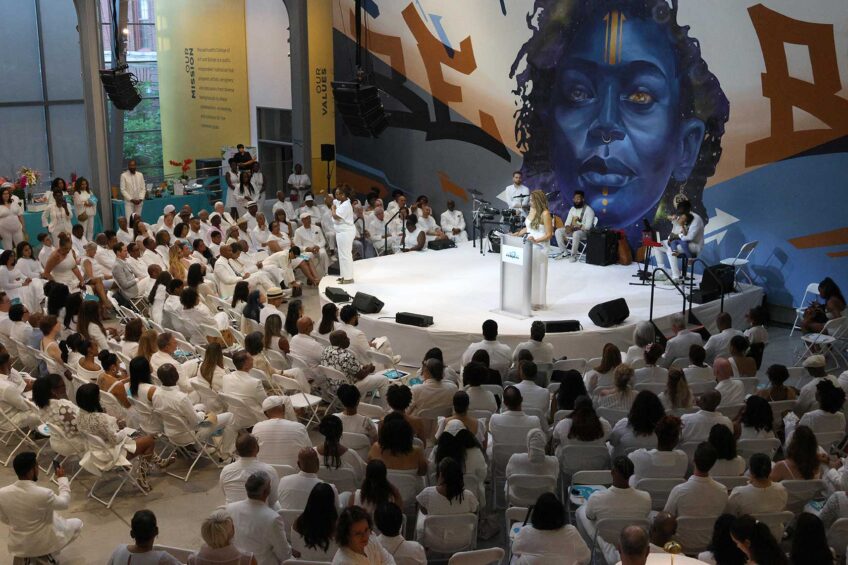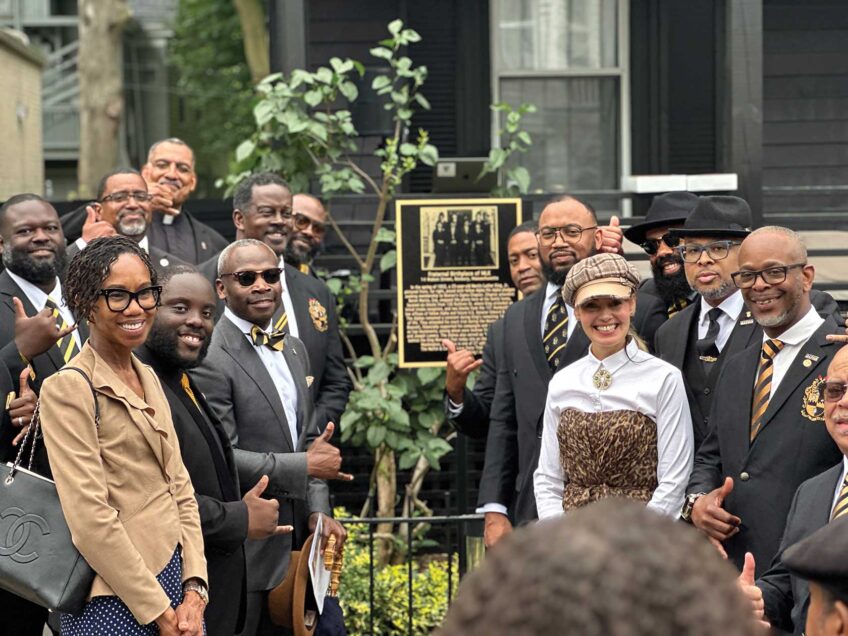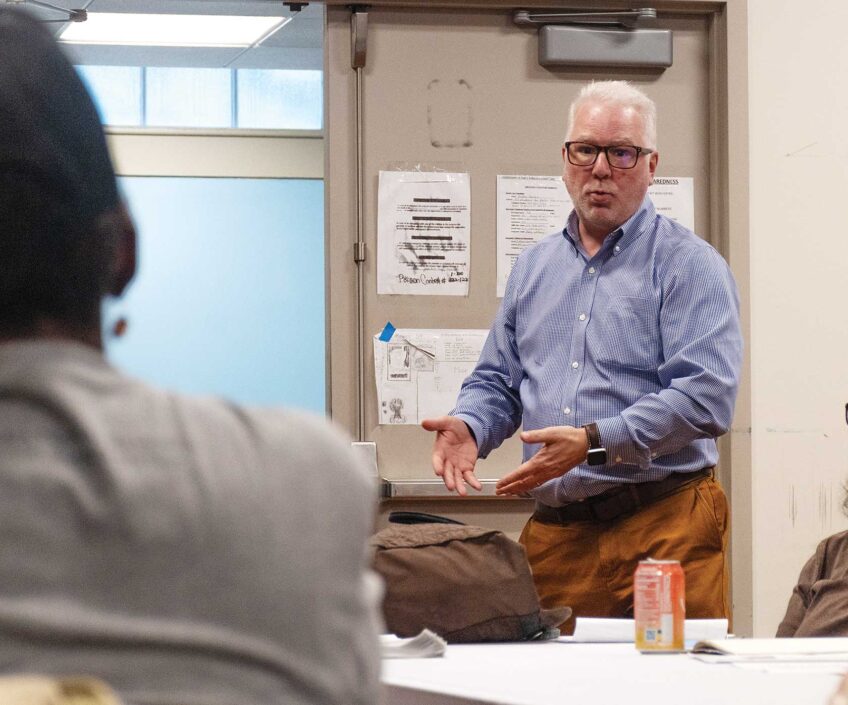Cultural, retail, entertainment destination envisioned for Lower Roxbury
A team of developers who hope to transform a vacant Lower Roxbury land parcel into a hub of culture and commerce presented their plans at a public meeting May 16.
The meeting was part of the formal approval process for “Tremont Crossing,” the residential, office, retail and museum complex proposed for the lot known as Parcel 3 on Tremont Street across from the Boston Police headquarters.
“This is the first official community meeting for this project; I do not expect it to be the last,” said Erico Lopez, Boston Redevelopment Authority (BRA) senior project manager, as he welcomed the 35 or so attendees and introduced the developers.
The meeting’s purpose was to present the plans to local residents and stakeholders, address questions and invite people to submit comments to the BRA before the June 1 deadline.
The project is proposed by P-3 Partners, a consortium that includes Feldco Development Corporation, a Connecticut-based firm experienced in shopping center and office building development, and Elma Lewis Partners, a development offshoot of the nonprofit National Center for Afro-American Artists (NCAAA) in Roxbury.
Feldco President Barry Feldman gave an overview of the project he termed a “true mixed-use development.”
The project includes 240 rental apartments in an 11-story residential tower; some 500,000 square feet of large-format retail, possibly including entertainment and recreational uses; 50,000 square feet of smaller retail facing Tremont Street; and 200,000 square feet of office space.
In addition, the plans include a large public plaza and 1,700 parking spaces in a multi-level garage. Approximately 58,000 square feet will be devoted to cultural facilities, including a new NCAAA museum.
Barry Gaither, NCAAA’s director and a member of the P-3 Partners team, spoke of the project’s cultural aspirations and the projected economic benefits for the Roxbury community.
“Many of you know that this project grew out of the vision of Elma Lewis, an extraordinary daughter of Roxbury,” he said. “She is known as the founder of the Elma Lewis School of Fine Arts and the Elma Lewis Playhouse, as well as the National Center for Afro-American Artists. This project will be a continuation of her educational and cultural legacy.”
The development is expected to generate 670 construction jobs and 1,738 permanent jobs in office, retail, museum, and administrative work. Gaither outlined a planned Office for Community Collaborations and Opportunities that will work on collaborations with local schools and institutions to create educational, internship and job placement opportunities for local residents.
In addition, Gaither said, the developers are committed to making annual contributions to the Whittier Street and Alice Taylor housing developments and to the Roxbury Trust.
David Lee of Stull and Lee, Inc., one of Tremont Crossing’s two design firms, described the project as part of a continued “re-imagining” of Columbus Avenue and Tremont Street from the South End to Jackson Square.
“The character of this street is going to change mightily,” Lee said. He drew a comparison to Boylston Street in the Back Bay — full of shops, restaurants, and people coming and going, “but with a distinctly Roxbury vibe.”
John Prokos of Gund Partnership explained how certain design decisions, such as placing the large stores and parking garage in the back and the apartments and small shops in front, aim to give the project a “permeable” feel, drawing people into its Grand Plaza and interior walkways.
“This should be a really exciting urban environment,” he said. “A place where you want to come to, live and work.”
Some traffic and parking alterations are planned. A left-turn lane will be added for cars turning from Tremont Street into the complex to access the parking garage. On Tremont Street, 32 short-term parking spaces will be added to allow drivers to make brief stops at the small stores or food establishments. Whittier Street will be changed to two-way traffic, with one side of the street restricted to resident parking to benefit Whittier Street residents.
Loading, delivery and trash pick-up will be done in interior spaces at the back of the complex.
In the question-and-answer period, several local businesspeople and residents expressed support for the project, but a number of questioners probed for details on parking, retail uses, construction jobs and phasing, and apartment sizes.
The team declined to name any specific retailers they have in mind, though Feldman said Walmart is not one of the companies.
“Similar to what you see in South Bay Shopping Center, but not duplicating them,” Feldman offered in response to questions about which large stores might occupy Tremont Crossing. He said there will be room for six or seven large stores.
In response to questions about small retail opportunities, Feldman explained they needed to solidify the large retail leases first, because lenders want early evidence of strong tenants.
The small-retail area can be divided to accommodate the space needs of different business owners, Feldman said. The price per square foot has not yet been determined. According to Gaither, the small retail is “being thought of very much in terms of local entrepreneurial opportunities,” but it was unclear whether any specific support or rent discounts will be offered to encourage and nurture small and local start-ups.
In terms of construction jobs, this will be a union project, though non-union workers may be eligible for some parts of the work. Gaither noted they are committed to exceeding Boston’s requirements for hiring local residents, minorities and women. They hope to start construction in fall of 2013 and finish in two years.
In response to a question about whether they might “buck the trend” of small, non-family-friendly apartments (the current plan lists only studio, one-bedroom and two-bedroom), Feldman said “nothing is written in stone” but they did use an “extensive residential market research study” to help determine the optimum mix of units.
Lopez reminded people to submit comments to him by June 1 at erico.lopez.bra@cityofboston.gov, or by mail to Erico Lopez, BRA, One City Hall Plaza, Boston, MA 02201. Themes or concerns that emerge in the submitted comments may dictate additional meetings to address those topics in greater depth, he said.
For more information: download the P-3 Partners slide presentation at https://www.box.com/s/b0985ca4e3221f4a2946; find the detailed Project Notification Form by searching for “Tremont Crossing” on the BRA’s website, www.bostonredevelopmentauthority.org.






